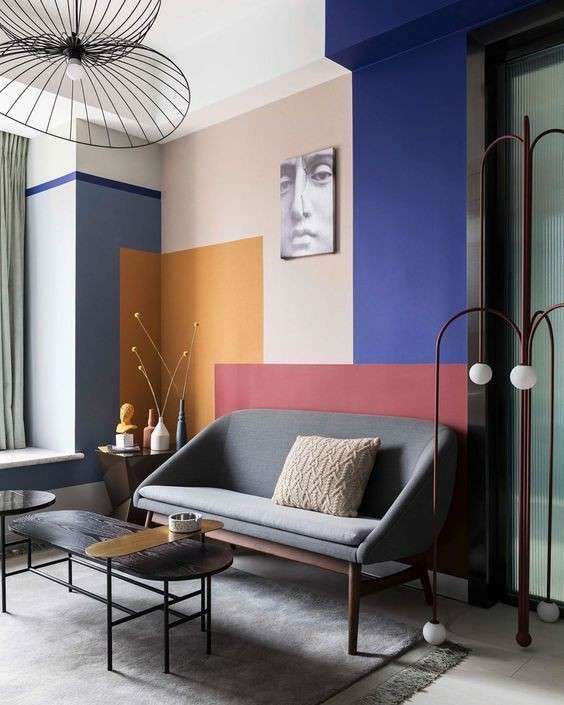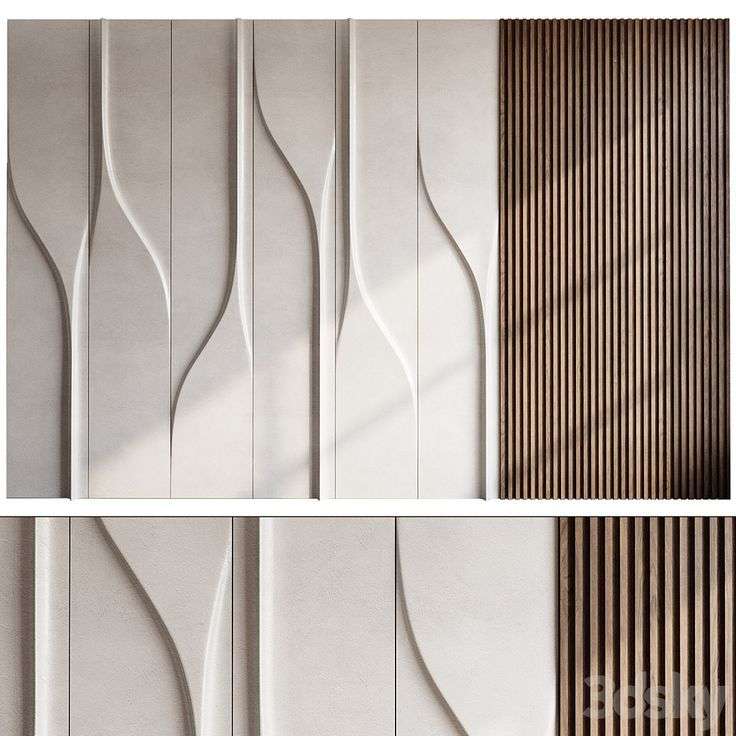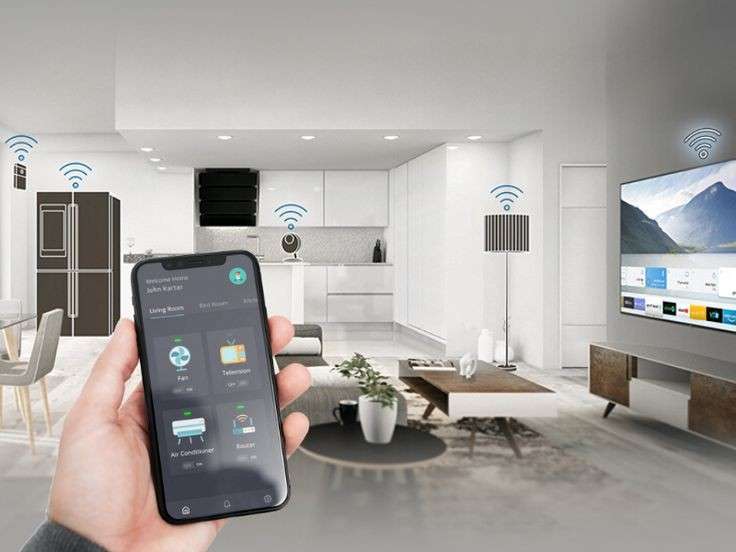At Scale & Structure, we believe that paint is one of the most powerful tools in interior design. It can set the tone of a room, enhance its mood, and even change how you perceive space. One of the most exciting and creative techniques we’ve embraced in modern design is color blocking—a bold, dynamic way to use color to make a statement. Whether it’s a feature wall, a dramatic ceiling, or a mix of contrasting hues, color blocking can transform any space into a visually captivating environment.
In this blog post, we’ll dive into the world of color blocking and show you how you can incorporate this technique into your home to create stunning, vibrant spaces.

1. What is Color Blocking?
Color blocking is a design technique that uses blocks of solid color to create visual interest, contrast, and impact. Traditionally, color blocking has been seen in fashion, but it has quickly become a popular choice in interior design, bringing energy and a modern aesthetic to both small and large spaces.
The concept is simple: contrasting or complementary colors are applied to walls, furniture, or other design elements in geometric shapes or patterns. This technique can add depth, highlight architectural features, and even make a room feel larger or more dynamic.
At Scale & Structure, we love working with color blocking because of its ability to inject personality and creativity into any space. Whether it’s a subtle use of pastel blocks or a bold pairing of primary colors, color blocking allows us to customize a room to reflect a client’s unique style and vision.
2. Why Color Blocking Works in Interior Design
Color blocking works so well because it draws the eye and creates a sense of balance and harmony. Here’s why it’s such a powerful tool in design:
- Adds Visual Interest: Solid blocks of contrasting or complementary colors can break up large walls or spaces, creating dynamic focal points that captivate attention.
- Creates a Sense of Order: While color blocking is bold, it can also help define specific areas in an open-plan room. By using color blocks strategically, you can segment spaces or create balance in a room without the need for physical dividers.
- Enhances Room Proportions: The use of color can make a room feel larger, taller, or cozier. For instance, light colors can expand a small space, while dark colors can add intimacy. Horizontal or vertical blocks of color can change how we perceive a room’s size and shape.
- Reflects Personality and Style: Whether you want to create a calm and serene atmosphere or a lively, energetic environment, color blocking allows you to tailor the space to your unique preferences. It’s a versatile design tool that can be adapted to suit any mood or aesthetic.
3. Creative Ways to Use Color Blocking in Your Home
Now that we understand why color blocking works, let’s explore some creative ways to incorporate it into your interior design. There are endless possibilities when it comes to how you can apply color blocking, from walls and furniture to décor and accessories.
a. Bold Accent Walls
One of the most popular uses of color blocking is on accent walls. Instead of just painting one wall a solid color, try dividing it into distinct blocks of complementary or contrasting colors. This technique draws attention and makes a bold statement.
- Vertical Blocks: For a sleek, modern look, try creating vertical strips of color along one wall. This works particularly well in narrow or tall rooms, as it can make the walls appear higher or more expansive.
- Horizontal Blocks: Horizontal stripes of color can give the illusion of a wider space and are especially effective in living rooms or bedrooms. Pair contrasting colors to create a striking visual effect.
b. Two-Tone Walls
Instead of committing to one color on an entire wall, try dividing the wall into two sections with a strong line separating the two hues. You can go for a classic, high-contrast combination like black and white, or experiment with more subtle tones like muted pastels or earth tones. Adding a horizontal or diagonal line between two colors can create an unexpected twist, making the space feel fresh and contemporary.
- Soft Neutrals: Pairing soft neutrals like beige and white with a bold color at the bottom can bring a sense of calm and sophistication to a room.
- Bold Contrasts: For more dramatic impact, choose contrasting colors like navy and mustard, or teal and coral. These color combos work best when balanced with minimal décor, letting the color blocking take center stage.
c. Geometric Patterns
For a truly artistic approach, consider applying geometric shapes with color blocking. By painting triangles, squares, or abstract shapes on the walls, you can create a space that’s as much a work of art as it is a living area.
- Triangles and Diamonds: Geometric patterns like triangles or diamonds can add a sense of movement to a room. Experiment with varying sizes and color contrasts to create a visually intriguing focal point.
- Abstract Shapes: For those looking to make a bold statement, abstract geometric designs in vibrant colors can be a conversation starter. This works well in modern spaces, such as an open-concept living room or a creative home office.
d. Color Blocking Ceilings
Most people forget about the ceiling when it comes to painting, but a color-blocked ceiling can be a dramatic and unexpected way to add depth and personality to a room. Consider painting a geometric shape on the ceiling that complements the colors on the walls. You could also block out a section of the ceiling in a contrasting color to draw the eye upward.
- Accent Ceiling: Use a bold color on the ceiling to contrast with lighter walls. For instance, pairing a muted gray wall with a vibrant yellow ceiling can bring energy and excitement to the space.
- Patterned Ceilings: Paint geometric shapes or lines across the ceiling, such as stripes or blocks, for a playful and creative vibe.
e. Color Blocking on Furniture
While walls are the most common place for color blocking, don’t overlook the power of painted furniture. A painted table, chair, or dresser with bold color blocks can elevate a room’s design. A contrasting color on the legs of a table or chair can also add a fun and unexpected twist to your decor.
- Two-Tone Furniture: Consider painting your cabinets, bookshelves, or side tables in two complementary colors to create a dynamic, multi-dimensional effect.
- Accent Pieces: For a subtler approach, add color-blocked accessories like cushions, throw blankets, or even vases and artwork. These pieces can enhance the color palette without overwhelming the room.
4. Choosing the Right Color Palette for Color Blocking
The key to successful color blocking is choosing the right color combination. Here are a few tips to help you choose:
- Complementary Colors: Choose colors that are opposite each other on the color wheel, like blue and orange or yellow and purple, for a high-impact look.
- Analogous Colors: For a more harmonious effect, choose colors that are next to each other on the color wheel, such as blue, green, and teal.
- Monochromatic Scheme: Stick with varying shades of one color to create a more subtle, unified design while still maintaining the block pattern effect.
5. Conclusion: Unleash Your Creativity with Color Blocking
Color blocking is a bold, creative way to bring energy, personality, and style into any room. Whether you’re looking to create a dramatic accent wall, add depth with geometric shapes, or refresh your furniture with a pop of color, this technique offers endless possibilities. At Scale & Structure, we embrace color blocking as a way to bring out the best in any space, ensuring that your home reflects your unique style and vision.
Ready to try color blocking in your own home? Reach out to Scale & Structure today, and let’s work together to design a space that’s as bold, creative, and inspiring as you are.



